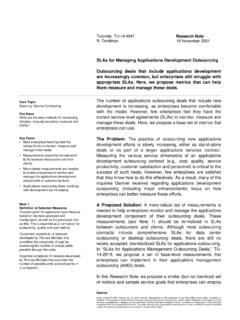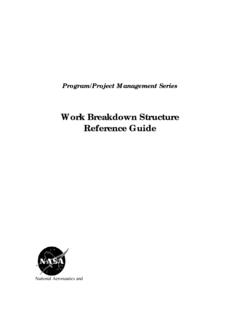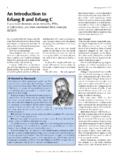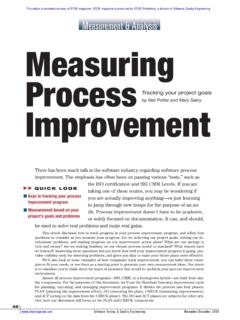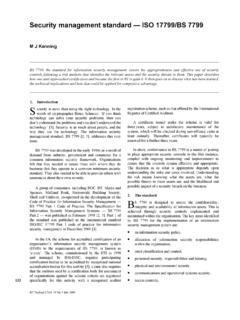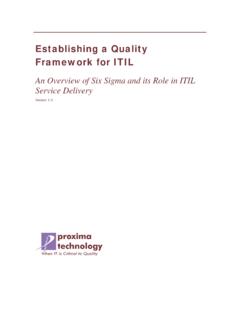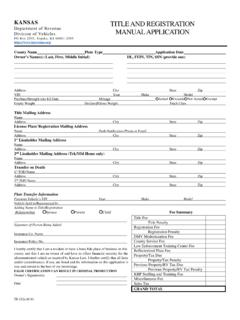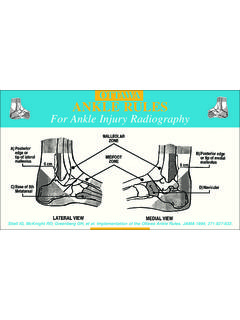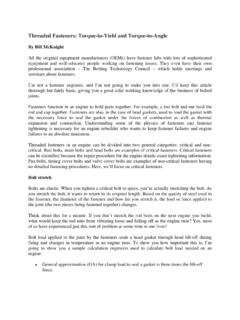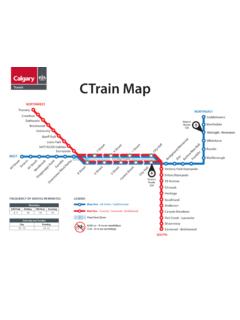Transcription of A McKnight Associates, Inc. White Paper - www.tarrani.net
1 A McKnight Associates, Inc. White Paper : Effective Data Warehouse Organizational Roles and Responsibilities McKnight Associates, Inc. 2000 1 Numerous roles and responsibilities will need to be acceded to in order to make data warehouse efforts successful and generate return on investment. For the technical personnel (application programmer, system administrator, database administrator, data administrator), it is recommended that the following roles be performed full-time by dedicated personnel as much as possible and that each responsible person receive specific Data Warehouse training.
2 The data warehouse team needs to lead the organization into assuming their roles and thereby bringing about a partnership with the business. Management also needs to make actionable plans out of these directives and make sure the staff executes on them. The following are team and extended team member composition and roles and responsibilities suggestions. Manager/Director The responsibilities of the Manager or Director of the Data Warehouse team should be to: Ensure support for the data warehouse program at the highest levels of the organization Understand high level requirements of the business Present the business with the possibilities available to them through data warehousing Staff the team Establish and ensure adherence to a set of guiding principles for data warehousing Communication of key milestone status to IT management Ensuring the remainder of the team accede to their responsibilities as enumerated below Liaise with strategic vendors Establishing partnerships with key IT partners in
3 Support of data warehousing initiatives Project Manager The perceived strength of data warehousing within an organization will be the sum of the strength of the Project Managers. Project Managers must deliver commitments and must deliver on time. They will do this by culling resources from within the data warehouse team and from consultancy as necessary and establishing partnerships with other internal support organizations required to support a data warehouse iteration. A Project Manager delivers by: Maintaining a highly detailed plan and obsessively caring about the progress on it.
4 Applying personal skill and judgment to everything on the project. This is a real value-add of the Project Manager. It is the Project Manager s job to exercise relevant discretion. Matching team member s skills and aspirations as closely as possible to tasks on the plan. Tracking all relevant metrics for each iteration: oProject Plan milestones oIssues list oAdherence to change control practices oAdherence to source code control practices oDocumentation fit for users and support personnel oArchitectural components adherence to fit for purpose and standards oRegression testing performed and tests updated based on changes oTeam members fit for tasks and career-enhanced McKnight Associates, Inc.
5 2000 2 Chief Architect The Manager/Director will need to rely on a Chief Architect (or similar title) position, as one of his/her direct reports, to work on complex issues of architecture, modeling, and tools. The person should be able to quickly qualify as an authority in data warehousing within the organization and have mastery of the data warehousing paradigm, both current and emerging technologies. His/her knowledge of the business needs to be just as great. A business technologist, s/he will meet business objectives with existing or emerging technologies and work on issues with broad technical or strategic implications.
6 This person would have significant interface with the internal clients and increase their confidence in the data warehouse organization. Data Steward (in user community - by subject area) Data Stewardship appointment should be made at the subject area to management-level personnel in the business areas most impacted by the subject area. For the core subject areas, this will be the person on the working team by appointment of the executive sponsor. Data stewards, unlike other users, have read and write access to their area of stewardship. Other users have read-only access to the Data Warehouse areas that they have been approved to read by the data stewards.
7 The responsibilities of a Data Steward include: 1. Arbitrating the transformation rules 2. Entering data or determining data population method 3. Verifying the data after load 4. Contribution of the business metadata 5. Approving new users 6. Supporting the user community on the data 7. Participation on a decision support steering committee 8. Data Quality A brief description of each of these responsibilities follows. The Data Steward is responsible for the transformation rules used in the process of moving data from source to target for sourced data.
8 The specific tasks are: Assuring transformation rules keep the data meaningful and consistent Arbitrate differences of opinion an different interpretations of value as to how the data will be represented in the Data Warehouse Make the call on the initial rules and all subsequent changes The Data Steward is responsible for the timely and accurate population of data in the area of stewardship. This is perhaps the most important of the Data Steward's tasks. This could mean manual entry through the developed user interface or the selection of the system that will provide the data (ie.)
9 The "source"). The specific tasks are: Determine the systems that will feed the data to the data warehouse Ensure feeds are developed to feed to the data into the data warehouse as soon as it is practical to do so on a regular basis McKnight Associates, Inc. 2000 3 The Data Steward, as the responsible party for the quality of the data, will verify the data after it is loaded from the operational sources. The specific tasks are: Confirm the data was loaded and that the transformational rules were properly applied Formally give the approval to the greater user community for query and analysis of the data The Data Steward will contribute the business metadata to the metadata repository.
10 The business metadata consists of the business definition written in terms the business can understand. The Data Steward will broker requests for new usage of the Data Warehouse. The specific tasks are: Knowledge of the data sources, transformation rules, and uses of the data for the area of stewardship Knowledge of the workload limitations of the Data Warehouse system for the area of stewardship Approve new users and their authority levels (usually read only) It should be a requirement for new users of the Data Warehouse to undergo training internally on both the data model and the data access tool.

